Peer to peer lending can be both an active or a passive investment. On the passive side of things, all an investor has to do is create an account and set up automated investing to reduce cash drag. After that, all it often requires is a monthly check-in to make sure everything is functioning smoothly.
This investment can be very active and hands-on.
On the other hand, this investment can also be very active and hands-on. This appeals to people who feel the extra time delivers them an increased return, or even those who enjoy the game-factor of peer to peer lending, where earning a higher ROI is almost a hobby.
Typically, a hands-on approach means examining the different available credit models that can potentially increase returns, or examining different filters to try and boost returns that way. Or, perhaps it simply means backtesting the open historical data to try and understand the benefits of adding or reducing risk via loan grades.
All in all, there is a significant degree of “play” offered within this investment. Third-party API tools combined with a rich set of open data becomes a perfect cocktail for inventing new and fruitful ways to increase your returns or decrease your defaults.
The Playground of the Folio Trading Platform
One of the most interesting parts of a p2p investment has to do with the fact that they are legally defined as securities by the SEC, and one facet of a security is its ability to be bought and sold on a secondary market. The partner company for both Lending Club and Prosper’s secondary market is Folio.
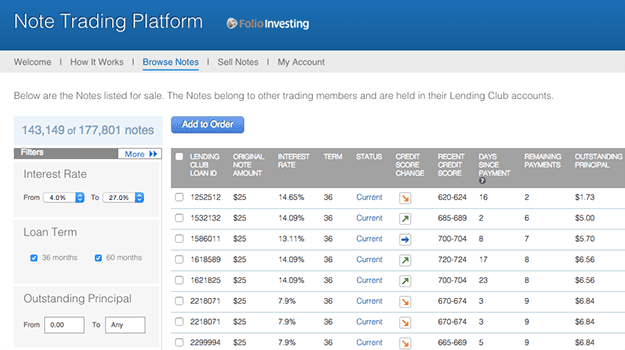
177,000 notes for sale on Folio
The Folio trading platform is perhaps the most vibrant (and risky) arena of investors trying to increase returns. You have people trying to sell notes for profit, people trying to buy discounted notes that are behind on their payments in hopes that they become Current later on, and everything in between. Read: Investing at Lending Club through Foliofn
Today we’ll look at selling notes for profit, particularly loans that are new with an Issued status.
Folio Buyers are Hungry for Good Notes
For whatever reason, there are people on the Folio secondary market buying up notes for a premium. Perhaps they live in one of the 17 Lending Club states that do not allow regular investing. Or perhaps they simply want to put their cash to work without waiting for regular loans to issue. Whatever the case, there is a sizable population of Folio buyers looking to pick up your loans.
Placing these notes for sale on Folio is completely free.
On your side of things, placing these notes for sale on Folio is completely free. Making them available doesn’t cost you anything except the few minutes of time it takes to set everything up. Folio does charge a fee in 1% of completed sales, so it’s important to keep that in mind. But as long as you’ve covered this fee with at least +1% markup per note, you can kind of play around with things. You are free to try and sell different grades for different markups/premiums, just to see what works.
Some people try really interesting and colorful combinations in hopes to increase returns, like offering 26% interest rate G-grade notes with 10 months of completed payments for a crazy +10% markup, a tactic that actually/sporadically works. See: The Liquidity Project results.
The Market for Newly-Issued Loans
A much simpler tactic is to simply sell freshly issued loans. Every loan you fund in the primary market ties up your cash for a few weeks before it issues. But if you can immediately sell these loans for a premium on Folio, you can earn an 19% ROI on them, adding a decent boost to your overall return.
Example: let’s say I invest $25 into a D-grade loan at Lending Club. This loan will take a few weeks to issue, requiring 100% funding and verification of the borrower’s identity. But upon being issued this D-grade note is immediately available for me to sell on the Folio trading platform. Let’s say I offer this loan for sale on Folio at a 2.6% markup ($25.65) and it sells in under a week.
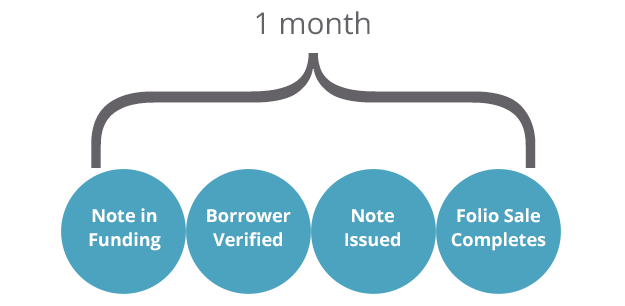
Effectively, I’ve earned an 19% ROI on this note. At a 2.6% markup, less 1% in Folio fees, I have earned a 1.6% in the four weeks my cash has been tied up (often less). 2.6% markup – 1% fees = 1.6% monthly return. 1.6%*12 months = 19.2% ROI.
This strategy just adds a bonus to ROI.
It won’t work all the time. Just a handful of my loans sell per month this way. But it does seem to consistently work with some degree success. I know one investor who has been boosting his overall return this way for many years. His overall return is much higher than my own, even though he has taken on less risk.
Also, be aware that this works best with riskier D-G graded loans worth $25-50. Buyers aren’t going to want to pay a huge premium if the loan itself has a really low return (like A-grades). And most buyers aren’t looking for $1,000 notes. But remember: placing notes for sale on Folio is free, so it doesn’t hurt to simply offer all your Issued loans for a steep markeup just to see what happens. I sold a B-grade loan in May for +2.6%. I also sold a few larger $75 notes this way.
What markup/discount should you choose?
This is going to be a YMMV problem (your mileage may vary). 2.6% worked for me. You may want to try higher markups, like +3 to +6%, just to see if things work. The investor I mentioned earlier actually sticks to +3% markups. On the other hand, you could try a lower markup if you invest in safer loan grades. Eg: selling A-grade loans for a +1.5% premium only earns you 0.5% after fees, 6% annually. But many A-grades only give investors 4-5% per year, so that +1.5% markup is actually a decent boost.
9 Steps to Sell Newly Issued Notes at Lending Club
This entire process might look complicated to a beginner, but it actually less than 60 seconds once you’re used to it.
Step 1: To begin, go to the Sell Notes area of the Folio trading platform by clicking on the link at the top.
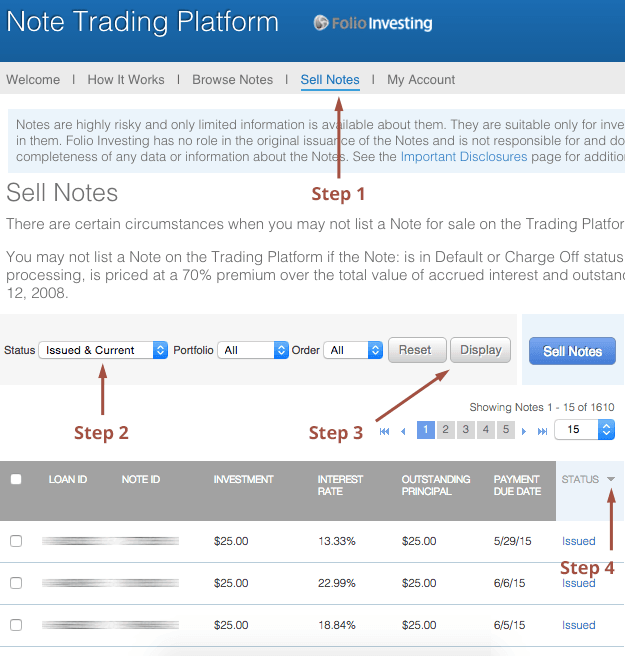
Once here, you want to pull up a list of all your notes with an Issued status.
Step 2 & 3: Isolate only Issued & Current notes and click Display.
Step 4: Move your issued loans to the top by clicking on the Status header until the arrow points down.
Now it’s time to select these issued notes.
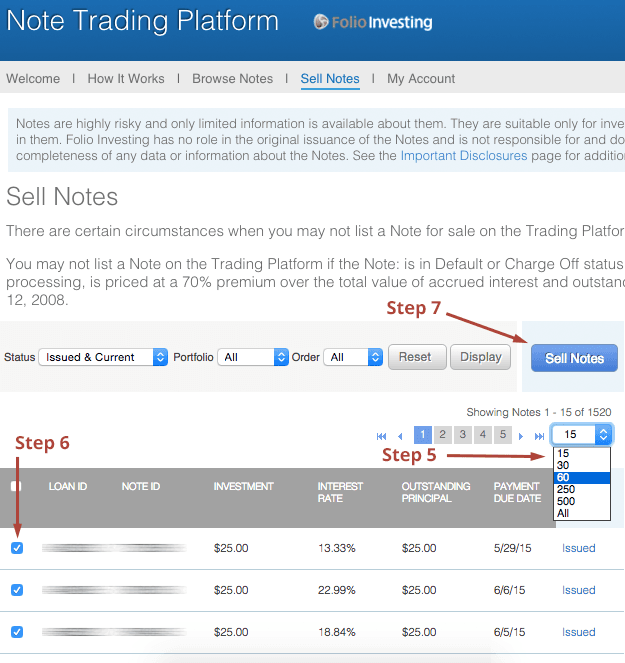
Step 5: If you have more than 15 notes with an Issued status, click the dropdown menu to have them all displayed. My account had 56 issued notes, so I set my list to display 60 notes at a time.
Step 6: Select your Issued notes. You can either select them one-by-one, or you can click the gray box to select them all and then deselect any Current notes that are at the bottom.
Step 7: Click the Sell Notes button to move to the pricing page, seen below.
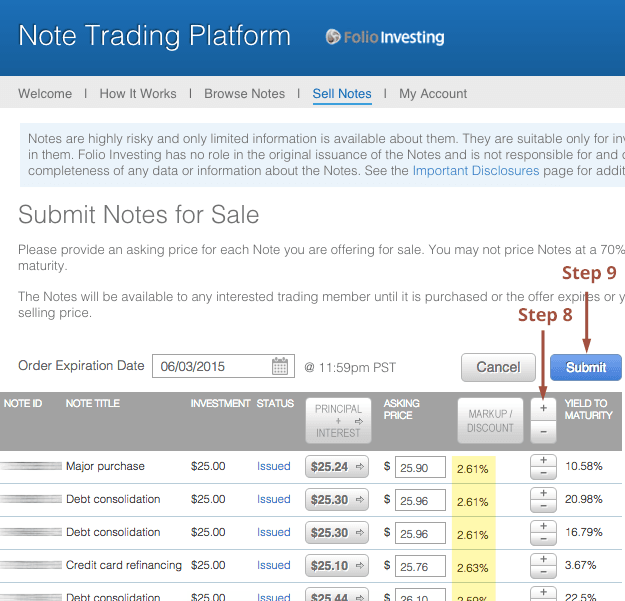
Step 8: Almost there! On the pricing page, you’ll want to click the big plus button (+) until every note has the correct markup or premium. For my account, I gave these notes a 2.6% markup, seen in yellow.
Step 9: Click the blue Submit button to place your notes for sale.
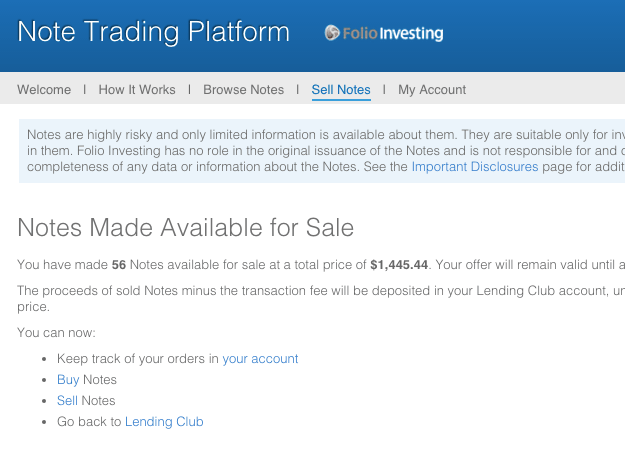
Nice! All of your notes with an Issued status are officially for sale on Folio. Now you’ll need to wait for buyers to pick them up. This can take anything from a day to a week. When your notes are purchased, you’ll get an email notifying you of the sale.
If a week goes by and notes remain unsold, the listings will expire. You should get an email for each note letting you know. In response, you can simply log back onto Folio and offer them for sale again. Eventually, you should have a number of notes sell.
Here are all the notes I sold in the month of May, 2015:
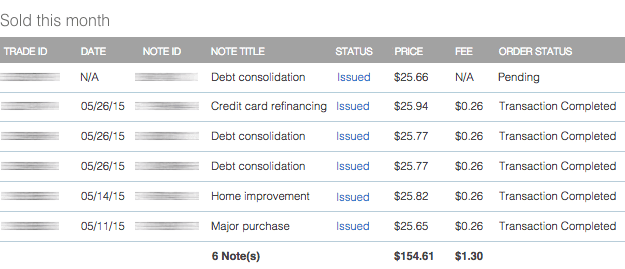
It’s worth reemphasizing that 5 out of 6 of last month’s sold notes are D-G grade. Most buyers of A-grades aren’t all that interested in paying a +2.6% markup.
Conclusion: An Increased Overall Return
If you don’t really have the time to mess with this stuff, you may want to simply add a 3% markup to all your issued notes one time and see if you get any bites. If you do, the 24% return may encourage you to incorporate this into your wider p2p lending rhythm. On the other hand, if your listings expire without any sales, no big deal.
The best approach is simply to be curious and explore the secondary market for yourself. Be smart and take time to play with different pricings until you find something that works. Folio is a bit of a Wild West. Its economy changes throughout the year, so with enough time this tactic may not work at all! That said, I think you will find at least a small degree of success, adding a decent boost to your overall p2p return.
[image credit: United Soybean Board “Soybean Sprouts During Early Growth” CC-BY 2.0]

I’ve not played with Folio yet, but to be honest when you mentioned Folio is THE secondary market, my first thought was “how do I build a Folio competitor so I can break the monopoly and get my 1% of all transactions.” The Levi model of profiting on the gold rush so to speak.
Unfortunately it’s not that easy to do. Becoming the secondary market requires becoming a broker-dealer like Folio is. I’m pretty sure the process to become a broker-dealer involves many hundreds of thousands of dollars in legal fees.
I used Folio for the first and only time back in 2010 when I liquidated my P2P portfolio for something I don’t even remember why.
But I do remember the loans selling rather quickly. Some sold at a premium, others at a discount. I ended up taking a small haircut on the loans but the interest I had collected had more than offset them.
And the small haircut was worth it at the time for the liquidity vs. waiting until the notes matured.
Cheers!
Funny timing. I’ve been doing this for the past few months and it has been great. I typically list all my notes for sale at 4-5% premium, and I’ve even been able to sell a few at 6%. The money then gets used to buy another note with the same filter and I list that note right away. It could push my annualized returns to close to 20%. I have found the Prosper Folio site extremely annoying, it won’t let you select all your notes at once so you can only list 10 at a time (and then i get 200 separate emails saying the listing expired)!
Nice work!
You can select to display ALL your notes on the Folio site (top right above notes listings), then you can select them all in one go.
Very true. Thanks David.
Are you sure you are not talking about the LendingClub trading site by Folio? It’s super easy to list all your notes from LC, but Prosper I still have yet to find a way to select all and not have to list 10 at a time
Nice write up! Does this also take into consideration the 1% fee charged by Lending Club? or is that charged only when you get paid each month?
Yes, this strategy takes into consideration the 1% Folio fee. And you only get charged 1% of repayments, and these loans haven’t yet had a payment, so that fee is avoided.
What about older loans with consistent on-time payments? If newly issued notes in the D-G range often sell for a premium, what happens to older notes not offered for sale on the trading platform until after several several months of on-time payments? It would seem, after 6 to 12 months, the riskier loans would be a better bet and hence should sell for a premium but that has not been my experience. On the other hand, as loans age beyond the one year mark, they would, I think, be less desirable since the longer the loan is outstanding and the lower the balance, the greater the likelihood the creditor will prepay. Or do you think the popularity of the newly issued notes is simply driven by the large number of investors from states that don’t permit investors to purchase notes directly, preferring to get in on the ground floor over someone else’s rejects? Has anyone ever done an evaluation of the ROI on older “never-late” loans?
Great article…learned quite a bit..Thanks
I noticed there were absolutely no $25 36 Month notes for sale with less than 36 months to go yesturday. I am trying to sell $25/36 mo notes with six months successful payments for a premium, I started at 10% and lowered a point every day or two, now I am 3% and they are finally starting to sell, but not like gang busters. I figured I would get a better primium, oh well. I will probably have to sell at a discount some of them that have credit ratings that are going down. They all have their first six payments in on time. Interesting. Any comments?
I actually sold one of these issued loans with a 3.5 % mark up today I was amazed, on how easy it was…
I’m gonna try this soon as my account funding is processed and my trader account fillings are done, buy A + B and sell them cheap and see if it’s worth it. I need to keep my money liquid anyway and even getting 4%-6% a year is a way better than what my savings account gives me.
I have sold my first 4 notes and have a 6% return so far so pretty good but a warning, as interest accruals on your note the percent doesn’t grow, so your return will actually drop as your principal and interest owed grows. I don’t know if I’m doing this wrong or what but I have to update my sales every couple of days because it deflates (only takes a minute…less actually) but it removes the passiveness from it a little.
For some reason I just started thinking about the tax implications of selling loans. Obviously if you are doing it in a self directed IRA it doesn’t matter, but for the rest of us I guess that depends on how long you have owned the loan? Capital gains for over a year or 40% if less than a year? That changes things. Any thoughts/insight?
how would you calculate the return from selling at 3% premium on loan that has 25 payments left?
I have put about 75 notes up for sell at a rate of 2.5% to 3% over a period of 4 weeks. Not one note sold. Every note at Grades D – G and all newly issued. Great article but maybe too saturated.
Hi Rich. How old were your notes? This article is for freshly issued notes that haven’t had FICO score changes, nor for those that have had any payments already made.
You wrote —
“….This article is for freshly issued notes…”
Wouldn’t there be an even better market for notes that have a good record of payments?
After all, wouldn’t you be more interested in buying a high yielding 3 year C or D loan when the borrower had already demonstrated their ability and willingness to pay and pay on time with a 12 months flawless payment record?
(Your article is very interesting, and is food for thought on yet another source on income the way you describe, and that’s something I’ll consider.
But my current main interest in finally trying out selling my Prosper notes on Folio was/is to answer my wife’s question of how easy, or difficult, is it to liquidate our Prosper holdings if unexpectedly we need the cash more than the investment. Perhaps you could do an article on that? For example, might it turn out that one can relatively reliably sell almost all their prosper notes if willing to take a 1% loss?)
And how does this work at tax time? Does Folio give you a statement of proceeds or does Prosper fold that in to their end of year reporting? I really like the idea/concept but I also don’t want to add tax headaches.
Folio/LC will certainly give you a tax statement, and yes the tax paperwork can be a little more after secondary market transactions, but many believe this is worth it.
Hi Simon – If I sell a loan from my Lending Club IRA and (I assume) the proceeds go back into my LC account, does the sale qualify as a taxable distribution or am I just moving pre-tax money around within the IRA?
Does Folio/Prosper in their tax statement indicate my basis (cost) of the notes one sells on Folio and/or whether I’ve held them more than a year or not?
If not, the tax reporting of profit/loss could be extremely tedious, even overwhelming, and error prone.
Hey, I love the site! So much information. I am in Alabama and we just go approved to start Lending Club!
I am curious what would stop people from taking out say 100% E notes and selling them on folio for even money a couple of months into it before the defaults start?
Then rinse and repeat?
Nothing. No guarantees that notes on folio will sell, and some miss their very first payment and won’t sell, unless for pennies on the dollar.
Great article. But I don’t get it. Started selling at 5% and down to 1% and have sold only 61 out of 1110 D-G loans with 2.5% in stages of default.
Ongoing for 1 week…. how low do I go to liquidate? How long to wait?
Notes are 1-4 months old.
I just went to Prosper’s routine that sent me to Folio’s open-an-account routine. “register to trade note.”
Folio wants quite a bit of info about my financial situation….
Income, liquid worth, net worth etc.
Are there some minimums I have to meet for them to let me play?
I prefer not to have more info about how much I’m worth “out there” in case someday Folio gets hacked…. so was going to somewhat minimize my liquid and net worth (not that it’s THAT high), but don’t want to get myself locked out by going too low.
If I’m investing through a Roth IRA on Lending Club do I need to open up a Roth IRA retirement account on Folio to sell notes? Or should I be opening a personal account?
Alex, you don’t open an account directly through Folio. Just login to Lending Club and click on the Trading Account tab and it will walk you through the application process. I did this both with my taxable and IRA accounts through Lending Club.
Just to be a little anal about the math, you’ve left out the fact that your initial investment actually generates some interest before you sell it. For example, taking the first loan in the picture under Step 7, you’re actually selling the Principal+Interest of $25.24 plus a markup of 2.61%. So the sale price of $25.90 is actually a markup of 3.6% over your initial $25 investment. After Folio takes their 1% you would get back $25.99*0.99 = $25.64 for a profit of 2.56%. Better yet, that’s an annual yield of 1.0256^12 or 35.4%! So you need to add about 16% to your stated 19% return.
Correction: $25.90*0.99 = $25.64 (I got excited and typed to many 9’s)
Hi Moneycle,
Can you explain why you would raise 1.0256 to the 12? My impression is that once you sell the loan, you get a profit of 2.56% and that’s the end of the story.
I raised 1.0256 to the 12th because I’m assuming that 2.56% was made in a single month’s time period. If you can successfully make 2.56% on your money every single month, then the compounding effect would mean that you could theoretically earn 1.0256^12 annually.
Does selling notes at a premium actually work?
Why would someone buy a note that has been marked up, rather than one thats been discounted?
That’s a reasonsble qhestion.
Two reasons. One is say I have a class seeing no pays 16% but it’s a seasoned note. That is Baroe has been paying regularly for 10 months now. This is a much lower risk than a brand-new loan and the chance of actually yielding 16% without defaulting is greater. So that kind of note should bring a premium price. The other reason is if I’m in a state where I am unable to directly engage in purchasing notes on prosper one way to get engaged in this game , and the only way, is buy notes that others are selling on folio. It’s still a very attractive investment to a lot of people are waiting for cross-pollination club to be available to investors and listing.
Love the idea. Have not been able to sell a single note after listing hundreds of them. Suggestions?
Hi Sol.
I put about 15 notes up for sale about half a month ago. I believe , if I remember right, about half of them sold at either face value or a discount of maybe 1%.. I could have put the remaining unsold nots up again for another 7 days, and maybe a few more would have sold.
If I remember right the seller gets to or can set a discount they will accept. Did you set a discounts? You may need to sell notes at a discount off their current remaining balance. It’s still possible to make a profit if you sell at a discount… But obviously not as much.
Did you set it that buyers woukd have had to bid 100%?
At different times notes may be more sellable or less sellable.
And seasoned notes
I set the numbers to make at least a 2 percent premium as the article suggests.
Sol,
2% premium is high… And depending on market conditions and how seasoned your notes are, may be unobtainable…as you saw.
Keep in mind that if you could even get 0.5% , and do that , say, every month by flipping , that,s about 6% annual interest above and beyond whatever interest you’re earning while holding notes. And it,s primitive taxed at capital gains rates…which is often to one,s tax advantages.
2% is high? This article recommends either 2.6 or 3 percent.
Hi again, Sol.
I guess “high” is relative. Of course I have no way of knowing , but only thing I can guess is 2% was high for YOUR notes (maybe not well seasoned notes?) and the date you were trying to sell. I DO have good reason and information that says that since the sort of scandal at Lending Club (think that was about a month ago) that it has sort of tarred (for investors) with a broad brush the attractiveness of investing in peer-to-peer notes. That was not yet true when the author of the article was suggesting trying to sell notes at over 2%.
I think the scandal will resolve itself favorably. It appeared to be limited to the CEO and he’s gone. I can’t imagine these notes ever selling for a 2 percent premium. It makes no sense to me when you can buy them at sticker. Do you agree?
Hi again Sol,
Well in my personal opinion I’d have not be optimistic about selling notes at a 2% premium. And as far as I remember none of mine sold that high.
But the author either did it didn’t sell that high.
As for why they MIGHT possibly sell at a premium:
1) A 5 year note that’s earning a high rate…say 15%+…and has been paying regularly paying on time for a year is definitely worth more than a new note.
2) if just stay neither lending club nor prosper operates, the only way I can invest in these kind of notes is buying them on Folio. Even if I have to pay ja premium.
I apologize if you have covered this but are you able to sell notes on Folio if invested in an IRA? I’ve heard during my research that people can’t when their in a Lending Club IRA account.
Yes, as far as I know you can sell loans via Folio in a Lending Club IRA.
Recently Prosper announced that they are discontinuing the selling of ANY notes on Folio.
Suggest you check if Lending Club is doing the same BEFORE worrying about if there’s a difference between having notes in an IRA or not in terms of selling.
While I was disappointed with Prosper for this recent decision, it did not surprise me. In contrast to Prosper, Lending Club has invested a great deal of time and energy into their secondary market, so I would be very surprised if they followed suit.
I checked directly with a lending club rep and he said they have no plans to drop Folio..the trading platform.
So likely not…though you never can be certain.
Since prosper will run Folio connection untill the 27th of Oct, wonder if I can …now that I have a newly opened Lending Club account..put my Prisper notes on Folio and pop over to Lenfing club and buy my own notes there?
(If others want to jump in there and by them at a premium price by out bidding me..so much the better)
No you cannot. Their secondary markets are not connected.
I wanted to liquidate my LC account of 180 $25 dollar notes. I listed all of my notes at a 3 percent markup on 10/11/16. Now on 10/14/16 3 days after, 16 of the notes sold. To my surprise 2 of the 16 notes that sold at a 3 percent markup were late 16-30 days, and those two notes both had credit scores higher than the original listing.